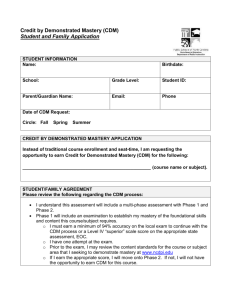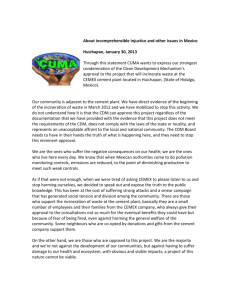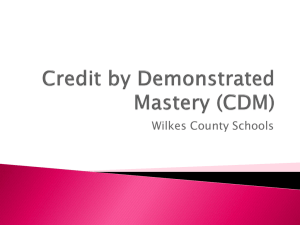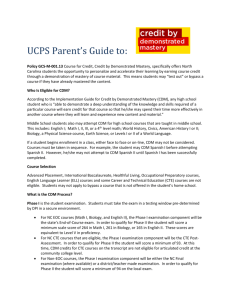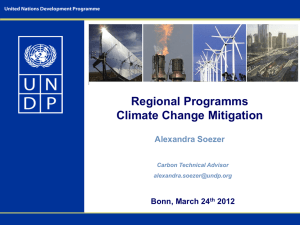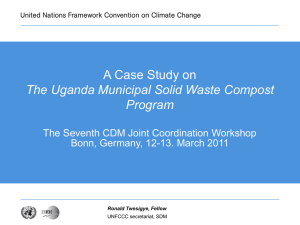4E1-EHR-Almost Final-mbj - The University of Oklahoma
advertisement
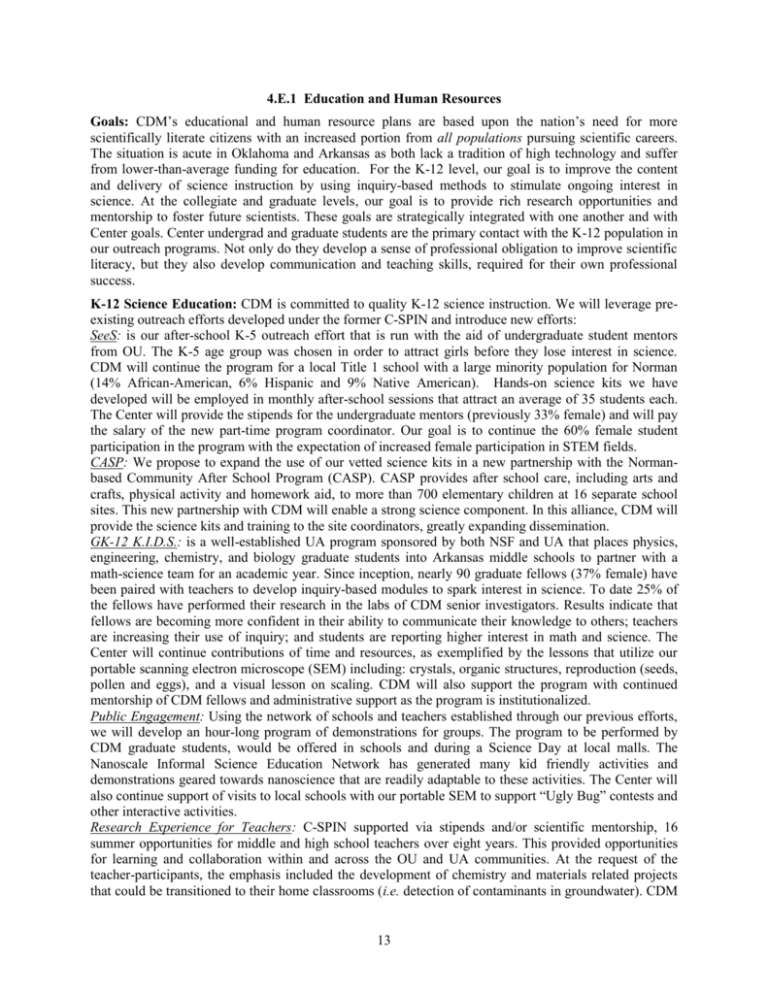
4.E.1 Education and Human Resources Goals: CDM’s educational and human resource plans are based upon the nation’s need for more scientifically literate citizens with an increased portion from all populations pursuing scientific careers. The situation is acute in Oklahoma and Arkansas as both lack a tradition of high technology and suffer from lower-than-average funding for education. For the K-12 level, our goal is to improve the content and delivery of science instruction by using inquiry-based methods to stimulate ongoing interest in science. At the collegiate and graduate levels, our goal is to provide rich research opportunities and mentorship to foster future scientists. These goals are strategically integrated with one another and with Center goals. Center undergrad and graduate students are the primary contact with the K-12 population in our outreach programs. Not only do they develop a sense of professional obligation to improve scientific literacy, but they also develop communication and teaching skills, required for their own professional success. K-12 Science Education: CDM is committed to quality K-12 science instruction. We will leverage preexisting outreach efforts developed under the former C-SPIN and introduce new efforts: SeeS: is our after-school K-5 outreach effort that is run with the aid of undergraduate student mentors from OU. The K-5 age group was chosen in order to attract girls before they lose interest in science. CDM will continue the program for a local Title 1 school with a large minority population for Norman (14% African-American, 6% Hispanic and 9% Native American). Hands-on science kits we have developed will be employed in monthly after-school sessions that attract an average of 35 students each. The Center will provide the stipends for the undergraduate mentors (previously 33% female) and will pay the salary of the new part-time program coordinator. Our goal is to continue the 60% female student participation in the program with the expectation of increased female participation in STEM fields. CASP: We propose to expand the use of our vetted science kits in a new partnership with the Normanbased Community After School Program (CASP). CASP provides after school care, including arts and crafts, physical activity and homework aid, to more than 700 elementary children at 16 separate school sites. This new partnership with CDM will enable a strong science component. In this alliance, CDM will provide the science kits and training to the site coordinators, greatly expanding dissemination. GK-12 K.I.D.S.: is a well-established UA program sponsored by both NSF and UA that places physics, engineering, chemistry, and biology graduate students into Arkansas middle schools to partner with a math-science team for an academic year. Since inception, nearly 90 graduate fellows (37% female) have been paired with teachers to develop inquiry-based modules to spark interest in science. To date 25% of the fellows have performed their research in the labs of CDM senior investigators. Results indicate that fellows are becoming more confident in their ability to communicate their knowledge to others; teachers are increasing their use of inquiry; and students are reporting higher interest in math and science. The Center will continue contributions of time and resources, as exemplified by the lessons that utilize our portable scanning electron microscope (SEM) including: crystals, organic structures, reproduction (seeds, pollen and eggs), and a visual lesson on scaling. CDM will also support the program with continued mentorship of CDM fellows and administrative support as the program is institutionalized. Public Engagement: Using the network of schools and teachers established through our previous efforts, we will develop an hour-long program of demonstrations for groups. The program to be performed by CDM graduate students, would be offered in schools and during a Science Day at local malls. The Nanoscale Informal Science Education Network has generated many kid friendly activities and demonstrations geared towards nanoscience that are readily adaptable to these activities. The Center will also continue support of visits to local schools with our portable SEM to support “Ugly Bug” contests and other interactive activities. Research Experience for Teachers: C-SPIN supported via stipends and/or scientific mentorship, 16 summer opportunities for middle and high school teachers over eight years. This provided opportunities for learning and collaboration within and across the OU and UA communities. At the request of the teacher-participants, the emphasis included the development of chemistry and materials related projects that could be transitioned to their home classrooms (i.e. detection of contaminants in groundwater). CDM 13 will continue this program, continuing to recruit teachers from local schools with high minority populations (e.g. Tecumseh, 34% Native American students; Tulsa McClain, 64% African American students). We will also recruit teachers from schools participating in our academic year K-12 programs to better tie our after-school outreach to in-class curricular requirements. Research Experience for High School Students: In the past OU and UA piloted a program for high school students to accompany teachers in RET summer sessions. CDM will formalize this process and support students from predominantly rural and minority serving districts to work on research in CDM labs. Assessment of K-12 and Community Outreach: The CDM will support Prof. Robert Tai (University of Virginia) to assess outreach efforts. Tai is an expert in early STEM education and factors influencing future success in science, including gender differences in performance and perception of science. He is a skilled consultant to evaluate informal (after school) impact and will meet with CDM outreach staff to tailor his evaluation instruments for our specific programs. Undergraduate & Graduate Education: CDM’s commitment to developing future scientists includes quality research experiences, topical instruction in nanotechnology, and professional development. Research Experiences for Undergraduates: Both campuses have had a long history of successful NSF REU programs with nano-science components. The most closely associated REUs are: the OU Physics REU, continually funded since 1996; and the UA MicroEP program funded from 2004-13, both up for renewal. A significant number of REU participants from these sites were engaged in meaningful research within CDM laboratories. We will continue to use the established structure (bi-weekly luncheon talks, field trips, accommodations) and recruitment networks to provide high quality research experiences within the renewed programs; and fund an additional five extra students per year at each site. Students will be selected based on talent and lack of access to research at their home institution. CDM will continue to coordinate a joint field trip for all program participants to visit high tech companies in Dallas. In our ongoing commitment to underserved groups, we have identified faculty liaisons at institutions with large minority enrollments: Northeastern State University (NSU) in Tahlequah, OK with the largest number of full-time Native American students enrolled nationally; University of Arkansas-Pine Bluff (UA-PB), Fisk University in Nashville and Norfolk State University in Virginia (all HBCUs); and University of Texas-San Antonio (UTSA), ranked #6 nationally for degrees to Hispanics. These faculty liaisons will direct talented undergraduates to our REU program. Nano-themed Courses: Under NSF-ILI funding CDM researchers developed Nanolab, a laboratory based course in nanofabrication accessible to all science and engineering majors, attracting students from sophomores to graduate students. As part of this proposal, CDM will offer this course in the summer at OU, allowing students from either CDM campus to enroll. Additionally, CDM will sponsor two Nanolab scholarships, providing tuition and housing allowance to NSU and UA-PB students. On the UA campus, students benefit from a host of nano-themed courses developed and taught annually by Center scientists. The support requested here will allow courses to have a larger enrollment and expand student experiences with materials and characterization tools. Diversity in Research: OU and UA are committed to actively recruiting students, postdocs and new faculty from under-represented groups. In addition to the RET and REU recruitment strategies listed above, the Center will also support a host of outreach efforts to promote STEM studies to women and minorities in high school (e.g. BP’s DEVAS and Engineering Academy summer camps). In addition, UTSA, a major Hispanic serving institution (MRI/HIS), is a partner in the proposed MRSEC. We will establish a bridge program between UTSA and UA/OU to bring students competing BS and MS degrees at UTSA to UA/OU to study and pursue a Ph.D. OU has also created a new position, the Director of Research Diversity Initiatives, who will focus on the development of faculty initiatives, collaborations, and perspectives that embrace diversity. CDM will work with the director and the corresponding partner at UA to assist and assess the Center’s efforts to improve research diversity. Our metric for diversity assessment will be the percentage of PhD students who are URM and females with a goal of 15% and 30%, respectively by 2020. 14


